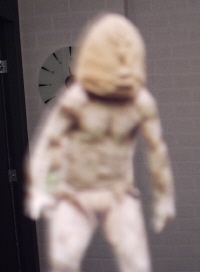 |
|
7/23/04-One of multiple "Mudman" images
to appear on cameras used by Robbert.
|
All photographs in this report were taken by Robbert van den Broeke,
unless otherwise noted. None may be reproduced in any format
without written permission from him or Nancy Talbott.
Text is © by Nancy Talbott, BLT Research Team Inc.
|
In July of 2004 another series of 50 +/- strange human-looking images began to appear on cameras used by Robbert. One evening an uncle of Robbert's (on his mother's side of the family) called to ask Robbert for help. The uncle had recently moved into a new house and was having trouble sleeping due, he felt, to the presence of an unusual "energy" which he noticed particularly upstairs in his bedroom.
On July 20th Robbert went to his uncle's new house and took a series of photos in the upstairs bedroom--eight of which contained a peculiar, but basically human-looking figure. At the time neither Robbert nor any of his family recognized these images as representing New Guinea warriors wearing traditional face-masks made of mud (used historically in ritual war dances).
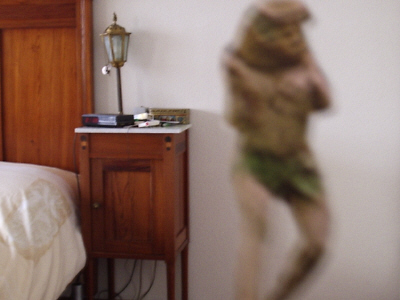 |
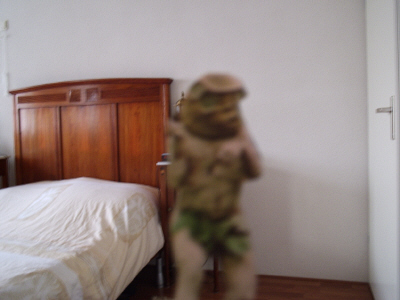 |
|
Two of 8 New Guinea "Mudman" photos (#1.1 & 1.2) taken at Robbert's uncle's
home July 20, 2004. Flash did not fire in any of the "Mudman" photos.
|
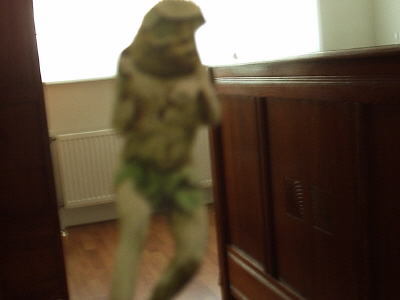 |
|
The third (#1.3) "Mudman" photo taken by Robbert at his uncle's home.
|
Below is a xerox copy of a photograph that was subsequently discovered as an illustration accompanying a Reader's Digest story about New Guinea warrior/shamans (1985-1992, Reader's Digest N.V., Amsterdam en N.V. Reader's Digest S.A., Brussels, "De wereld van het ongrijpbare," p. 23, printed in Germany, ISBN 90 6407 1128).
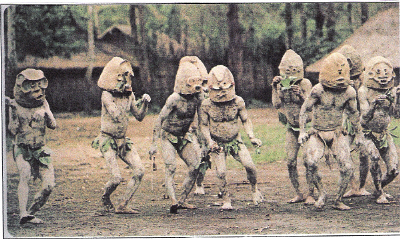 |
|
Photo accompanying Reader's Digest article about New Guinea "Mudmen."
|
The man on the extreme left in the Reader's Digest illustration looks most like the figure which appeared in the photos Robbert took at his uncle's home.
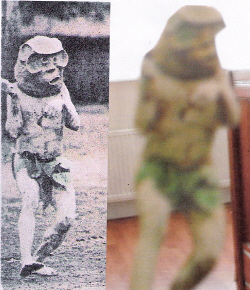 |
|
The Reader's Digest photo (left) & the #1.3
"Mudman" photo (right)taken at Robbert's
uncle's home.
|
As was the case with the the "soldier" photos in Part 1 we again observe the curious circumstance of only one particular individual--who in a previously-existing photograph was part of a group--now appearing alone. In the photos taken by Robbert at his uncle's house it certainly looks like this particular "Mudman" has been rather ineptly cut out from a printed copy of the Reader's Digest photo and then somehow super-imposed or inserted into the shots taken by Robbert in his uncle's bedroom.
I sent our photo analyst these three "Mudman" photos taken at Robbert's uncle's home first, before sending the multiple other "Mudman" shots taken a few nights later at Robbert's own home. The analyst concluded, particularly in regard to image #1.3 (with its Reader's Digest comparison, above) that "some photo tampering" was most likely involved in the creation of Robbert's shot--specifically, most likely involving a computer using something like "Photoshop" software.
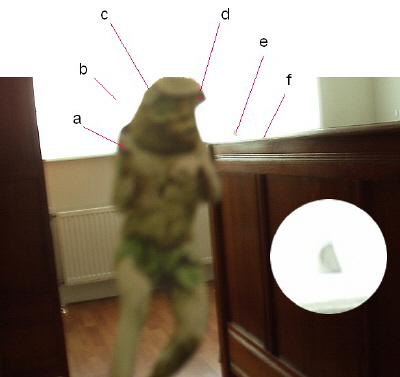 |
|
Multiple effects pointed out by BLT's photo analyst in image #1.3 which he
felt indicates photo tampering ("a" through "f" itemized below).
|
(a) The mudman's right hand has been cropped out (as compared to the
RD image);
(b) The white background (window region) is absolutely as white as is
possible (RGB values 255, 255, 255) over the entire window area,
a situation which is pretty unlikely naturally;
(c) The head clearly appears to be "cut out" and it is not out of focus, in
spite of the brilliantly white background behind it;
(d) The eye-socket is improperly cropped (as compared to RD image);
(e) There is a free-floating shard of something in window area (magnified
in white circle) which looks like an artifact which could have been
inadvertently missed if a "magnetic wand" tool on a computer had
been used to erase details in the window area;
(f) The top of the bed rail (on left, near window) seems to have been
trimmed--this effect could be the result of the bright light adjacent to
an unfocussed region, but our analyst thinks this is not likely.
Our photo analyst also points out that the lighting of this mudman figure is inconsistent with the lighting in the bedroom (i.e., the mudman is lighted more as he is in the RD photo, rather than he would have been had he been physically present in the room), another factor regarding this particular photo which he could only attribute to someone having "tampered" with the photo, most likely using a computer.
But as reasonable and straightforwad as our analyst's rationale is regarding this photo, it provides only a possible scenario--but one that, in this case, does not account for the actual facts.
In July 2004 Robbert was totally unaware of the existence of New Guinea "Mudmen" or the Reader's Digest (or any other similar) photograph--so, obviously, he could not have come to his uncle's house prepared with a "cut out" of such a figure. Several people were watching Robbert while he took these photos and none of them saw Robbert do anything other than hold the camera up a few feet in front of his head, aim the lens in the direction where he "felt" the energy, and then push the record button. Like dozens of Robbert's clients (upon whose cameras a wide variety of strange images have appeared during their sessions with Robbert), the people present in this case assert that Robbert did not hold anything in front of the camera lens when he took any of his photos that afternoon.
Further, all of the mudman images which appeared as Robbert continued to take photos were seen by everyone present on the camera's LED screen immediately after they were taken --while everyone was still in the bedroom. It's interesting that, as is usually the case, none of the people present (including Robbert himself) saw the mudman visually--the images appeared only on the camera's LED screen as Robbert took each photo.
But the most important fact to note, particularly for people with technical expertise, is this one: Robbert did not have a computer in July, 2004--nor even the slightest inkling of how to operate one.
____________
During the evening of July 23-24, 2004, four days after visiting his uncle's house (and before he or any family member were yet aware of the Reader's Digest photo) Robbert felt a strong energetic "presence" in his own home and began taking photos just after 11pm. Over the next week he took about 50 images of a similarly strange, but different, "mudman" in various rooms downstairs in his own home.
Just one of these "mudman" images taken at Robbert's home--the one that seemed the clearest--was subsequently released to the public, initiating a barrage of fairly intense debate, based apparently on the discovery by one of Robbert's critics of the Reader's Digest illustration photo. It was then implied, or in some cases aggressively asserted, that Robbert had "faked" this one "mudman" photo which had been made public.
 |
|
Original of "Mudman" photo (#2.1) released to the public. Photo taken on
July 23, 2004 at 11:36pm, in Robbert's office.
|
It's ironic that the one "mudman" image made public happens to be the easiest one for technically capable individuals to conclude is computer-generated. Although I can't read Dutch I have looked through several of the Dutch web-sites on which articles are posted which challenge the authenticity of this photo--and from the amount of copy present on the internet it appears that quite a bit of time and effort was expended to "expose" how Robbert supposedly produced this photograph.
But as has repeatedly been the case in the past, no effort was expended by any of Robbert's accusers to gather any additional details or actual facts from him or his family--no interviews were asked for, or conducted.
The hubris of people in possession of only one piece of information--people who are totally uninformed of the entire situation--is a bit staggering. One Dutch web-site presents a convincing demonstration that the "Mudman" photo released to the public (#2.1, above) is a "100%" replica of the "Mudman" figure on the right side of the Reader's Digest illustration. Although the argument presented is at first glance compelling, it is not 100% accurate--nor does it prove Robbert "faked" this--or any other--particular photo. This will become evident as we look at the BLT photo analyst's findings in his examination of Robbert's "mudman" photos.
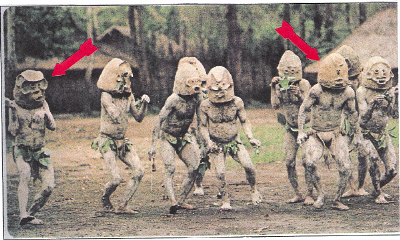 |
|
Arrows point to the 2 Reader's Digest "Mudman" figures most similar to the images
obtained at Robbert's uncle's home (left) and at his own (right).
|
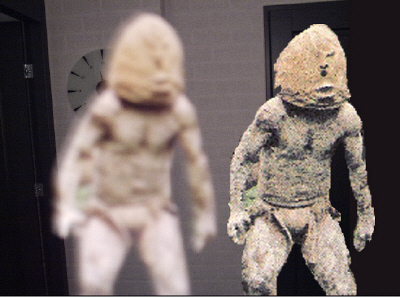 |
|
Robbert's "Mudman" (#2.1) photo (left) released to public & most similar
Reader's Digest
figure (right), sized to match & with part
of loin-cloth excised from RD image.
|
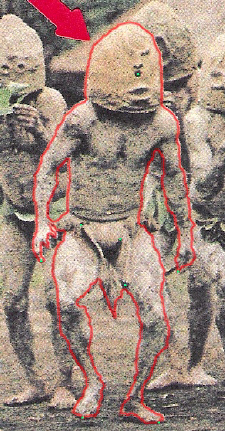 |
|
BLT's photo analyst draws a red outline
around the Reader's Digest figure
(including all of loin-cloth) & inserts
green registration dots.
|
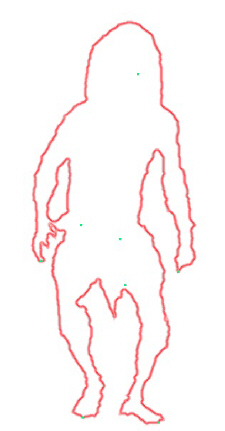 |
|
The red silhouette of the Reader's Digest
image with green registration dots at
specific locations.
|
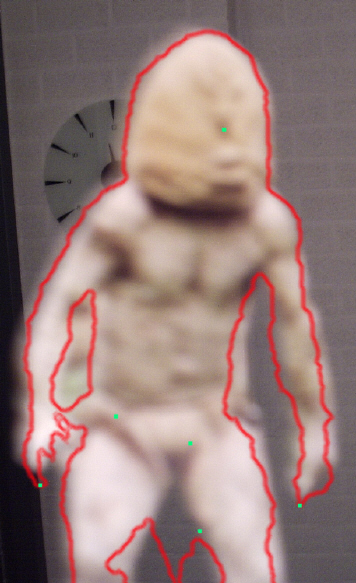 |
|
When the red silhouette is placed over Robbert's "mudman" photo
#2.1 (both images sized to fit), the silhouette--although
close--is not a 100% match.
|
Our photo analyst notes that the left torso and both hands in Robbert's "mudman" #2.1 photo are notably different from the Reader's Digest silhouette and states that, although he feels there is a "high likelihood" that the #2.1 photo represents the same figure as seen on the right in the RD illustration, he cannot explain "the deviation (on the left) in the torso."
On the night of July 23-24, 2004 many other "mudman" images appeared on Robbert's camera. Here are some of those images, examined in the same manner as the one photo (#2.1, above) released to the public.
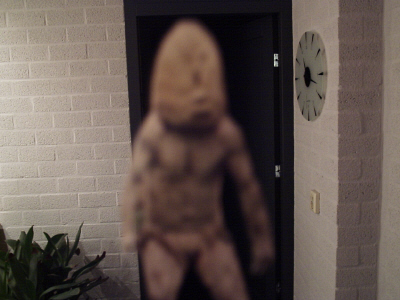 |
|
July 23, 2004 @ 11:21pm: image #2.2, original photo.
(Time-stamp on camera is set a few minutes ahead of clock on wall).
|
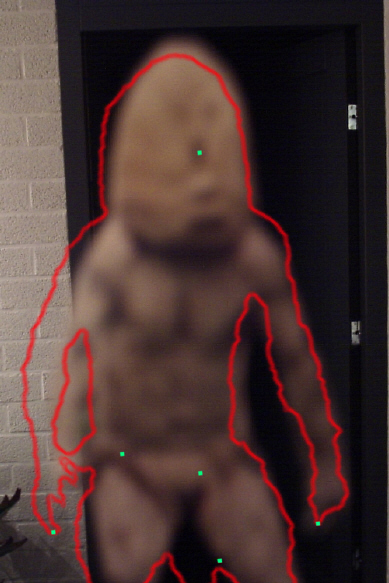 |
|
[Mudman 2.2 cropped & enlarged by photo analyst.]
Best match (after multiple trials re-sizing & rotating figure) of RD figure's
red silhouette and reg.dots to Robbert's photo #2.2. But the head
shape is "qualitatively" different, the figure appears thinner,
& it's right arm is much closer to the body.
|
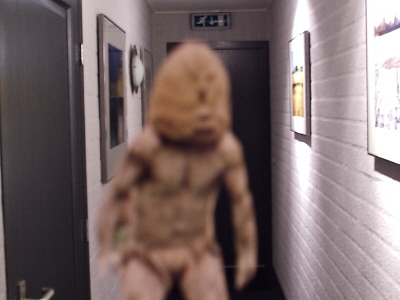 |
|
July 23, 2004 @ 11:22 pm: image #2.3, original photo.
|
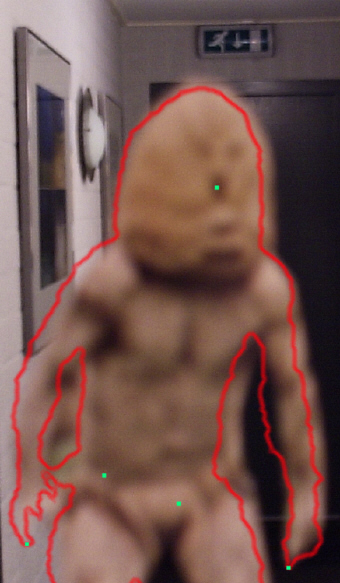 |
|
[Mudman 2.3 cropped & enlarged by photo analyst.]
Best match (after multiple trials) of RD figure's red silhouette to
Robbert's image #2.3. Reg. dots are pretty good,
but both arms' positions are not.
|
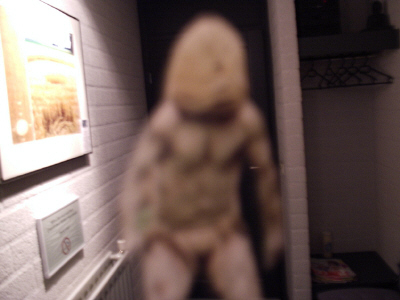 |
|
July 23, 2004 @11:25 pm: image #2.4, original photo.
|
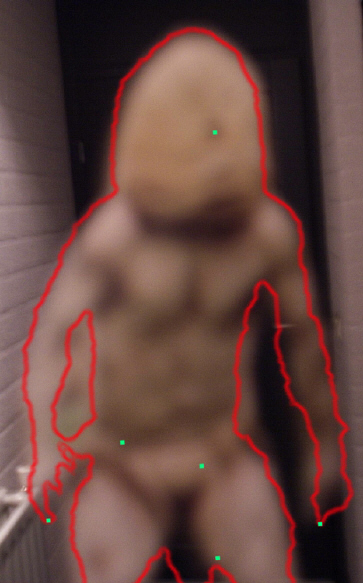 |
|
[Mudman 2.4 cropped & enlarged by photo analyst.]
Best approximation after multiple trials to match RD's red silhouette
to image #2.4, a closer match but still not 100%.
|
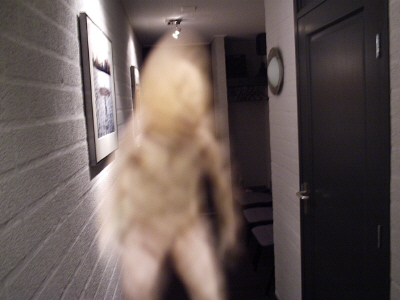 |
|
July 23, 2004 @ 11:40 pm: image #2.5, original photo.
|
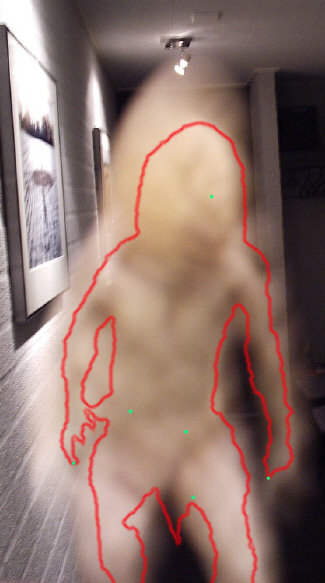 |
|
[Mudman 2.5 cropped & enlarged by photo analyst.]
Again, when the RD silhouette is superimposed over Robbert's
image #2.5 one can see that red outline & many registration
dots don't line up.
|
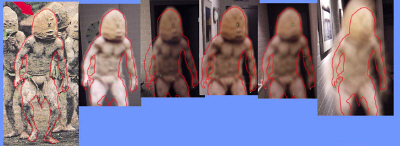 |
Of the five "mudman #2" images shown above our analyst asserts that #2.2 could not have been derived from the Reader's Digest illustration. He states that the others might possibly have been adapted from the magazine photo if a computer program such as Photoshop was used, but goes on to say "it seems more likely that all of the photos came from the same source...since the masks, clothes, and physiques are similar."
Although our photo analyst felt that many of these "Mudman" images above could have been derived from the Reader's Digest illustration by someone using a computer equipped with image-altering software such as "Photoshop," he was certain that images #2.2 and #2.11 (dark image, 6th photo below) could not have been. And he raised an interesting question which, in my opinion, may take us closer to a possible understanding of all of these photos.
As with the "soldier" photos, is it possible that in both situations either multiple images--or perhaps even film footage--had been shot, but only the one "soldier" group photo and the one Reader's Digest "Mudmen" group image actually published? In other words, is it possible that multiple images in both cases were physically documented in the same basic time-frame and did exist (or still do) somewhere? And that Robbert is somehow (when he perceives this unusual "energy" present in his immediate environment) accessing and recording images which actually did exist in our "normal" physical reality...at least at one point in time?
Since I know for certain that Robbert did not physically create any of these images himself, and since I also know (from direct personal observation) that he often has no idea of who the people are who appear on the cameras he uses (thus, it seems to me, ruling out the idea that he is "generating" the images mentally himself), the possibility that he is somehow inadvertently accessing scenes or events from some other place and/or moment in time seems quite reasonable. Exactly how he does this I don't think he, or anyone else, yet knows.
Several other "mudman" images appeared on Robbert's camera during the same night as the images above. Many of them occurred only seconds apart. Some were almost completely transparent and, after the first group (which had all appeared in Robbert's small office or the hallway leading to it), they also appeared in various other rooms downstairs.
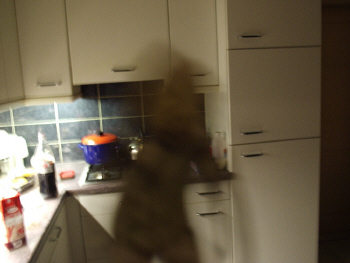 |
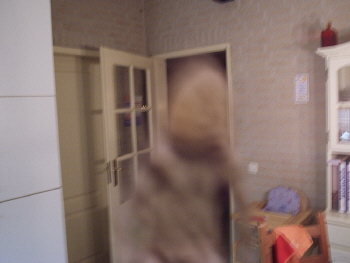 |
|
Two of the first "Mudman" images to appear on July 23, 2004, both in
the kitchen & only seconds apart (11:08:09 pm, 11:08:41 pm).
|
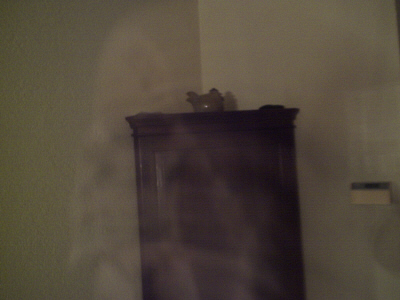 |
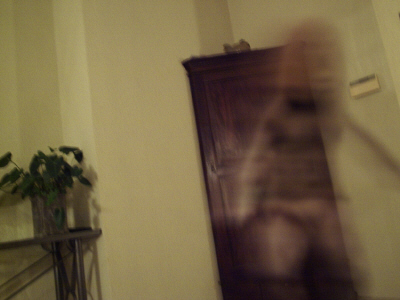 |
|
Two more, one nearly transparent, the other more opaque. Note the wider
extension of the figure's left arm, which is not consistent
with the RD image.
|
I don' t have copies of all of the "mudman" images which appeared at Robbert's cousin's house or, over the following weeks, at his own house. Of those I have which were taken in Robbert's house the time-stamps on the photos begin at 11:08pm on the night of July 23rd and end at 2:15am, July 24th (photo below)--slightly more than a 3-hour period of time.
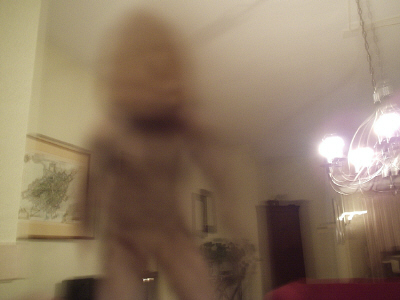 |
|
July 24, 2004 @ 2:15 am (original photo). Last shot I have in "mudman" series
taken on July 23-24, 2004.
|
In the photo above, which is the last one time-wise that I have, both the head configuration and the extended left arm is different from any of the "mudmen" in the Reader's Digest illustration. Note also the distortion of objects in the room behind the figure.
But the most obviously different of the "Mudman" photos Robbert took at his home is unusual in more than one way. One aspect--the overall darkness of the shot--fits a condition we have noted over and over when a range of photo anomalies are occurring (Part 2, "Alterations in Ambient Light": http://www.bltresearch.com/robbert/photoanoms2.php).
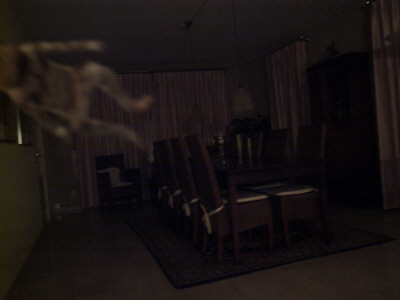 |
|
July 24, 2004 @ 1:32am: image #2.11 (original). Crouching position of this
figure doesn't match any of the RD "mudmen."
|
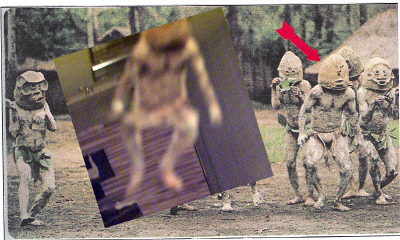 |
|
Photo analyst has altered the contrast and rotated Robbert's figure #2.11 &
inserted it into the RD photo to illustrate the difference of the figure's pose.
|
There are two other photographs that I feel belong to this group. During July, 2004, Robbert was beginning to find many people he could not identify appearing in his photos. The man below is one example, taken during the same time-frame as many of the "mudman" photos. And, for some reason I fail to understand but feel is likely important, in all of the anomalous photos in which people appear, the flash never fires...regardless of the actual light conditions.
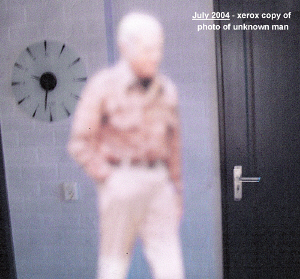 |
|
Unidentified man who appeared several times
during July, 2004.
|
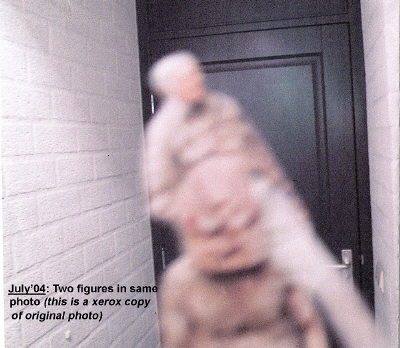 |
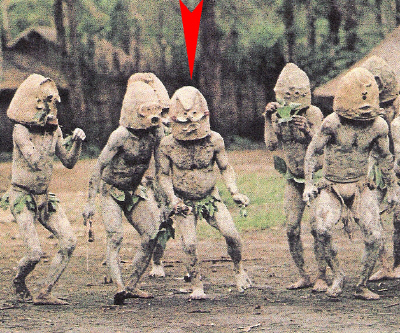 |
|
Mudman in photo with unknown man (top) looks like the center mudman in
the Reader's Digest image (bottom). It's also the only "apparition"
photo I've seen with 2 clearly different figures present.
|
I know it's a challenge for people with computer expertise to even consider the possibility that something NOT related to modern technology (or sleight-of-hand) is behind Robbert's photos. And I know, personally, how difficult it can be to deal with the resulting cognitive dissonance when one's "reality" paradigm is confronted by such ideas. But I've lost respect for individuals who publicly claim both a sincere interest in such things as well as their own competency, but then fail to conduct even a minimally professional inquiry--choosing instead to simply broadcast their own bias and claimed expertise in their criticisms of Robbert and/or his photos. Such egocentric attacks are, in my opinion, billboards advertising nothing more than presumptive arrogance and/or laziness, albeit in the guise of "professionalism."
Emile Chartier put it so succinctly:
"nothing is more dangerous than an idea--
when it's the only one you have."
<< Return to Part 1 | Top | Continue to Part 3 >>
© 2010 BLT Research Team Inc.
All Rights Reserved
|
|































